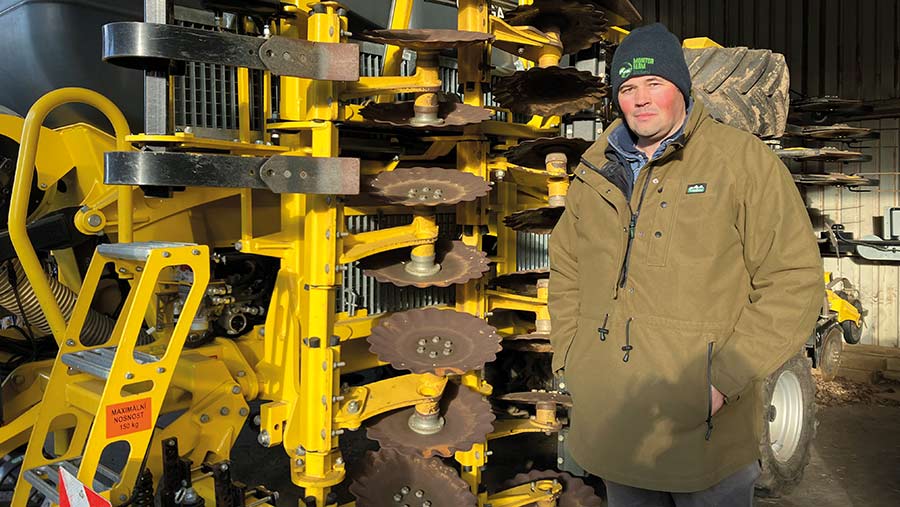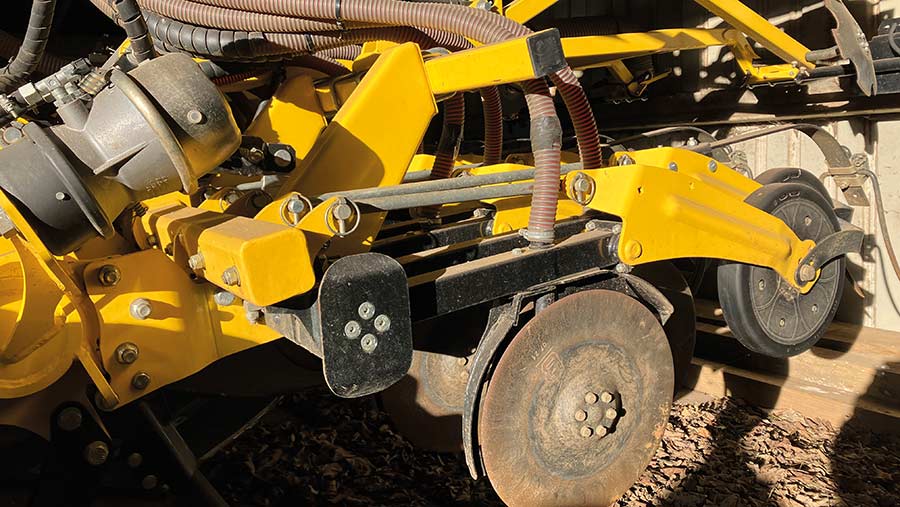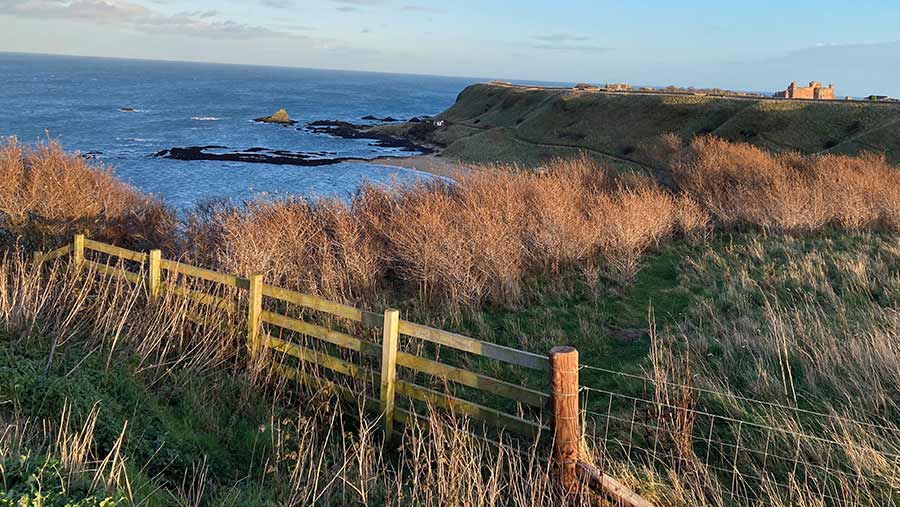How strip-till drill offers flexibility in low-cost system
 © MAG/Emma Gillbard
© MAG/Emma Gillbard Scottish grower Stuart McNicol is on a mission to build a simple and cost-effective arable system at Castleton Farm on the North Berwick coast.
Farming 160ha with just the one tractor for the past 12 years certainly proves his ambition to achieve this.
See also: Variety choice and targeted N are vital for Scottish grower’s potato profit
Centre to his money-saving approach lies a flexible establishment strategy offered by a Bednar Omega strip-till drill, which he has used for the past two seasons.
This has seen fuel use plummet as low as 5 litres/ha compared to 45 litres/ha associated with traditional cultivation or ploughing at the farm, which lies on the edge of Tantallon Castle.
“The drill is essentially a three-in-one machine,” notes Mr McNicol. “It’s compatible with strip-till, min-till and plough-based systems.”
Flexible cultivations
Sharing the philosophy behind his approach, he aims to make the business as simple as possible.
“There’s only me and the Case Puma 165hp tractor. We have a sprayer, combine, couple of cultivators and the plough, but the strip-till drill offers a blended approach with so much flexibility.”
Targeting cultivations to weather, soil and agronomic conditions is essential for successful crop establishment, especially when faced with strong, cold winds and an annual rainfall of 71cm on the eastern coast of Scotland.
Castleton Farm as new AHDB Monitor Farm host
Castleton Farm is the new East Lothian AHDB and QMS Monitor Farm host, where Stuart McNicol and his wife Jo welcome the opportunity to discuss farming practices as they start the four-year programme.
“It’s all about knowledge transfer; trying to make things better, not just for our farm, but for industry. We have some challenging times ahead and we need to be prepared. That’s where the Monitor Farm comes in,” explains Mr McNicol.
Over the next few months, the programme will be collecting data, seeking 10-12 farm businesses to sign up to be part of its management group.
The group will provide input to the Monitor Farm, as well as collating data to drive improvement in their own businesses.
At the latest farm visit, attendees discussed reducing artificial fertiliser use with the help of sheep, and the potential for using the farm’s sprayer to apply “home-brew” nutrients to crops.
Individuals can join the wider community group to stay informed about the project and attend future events.
The drill’s double-disc set cuts crop residue and slices a 20mm slot into the soil in one-pass, cultivating only the strip that is tilled.
The seeds are then covered with fine soil and pressed down into the ground.
However, due to reduced seed-to-soil contact compared to more traditional establishment methods, Mr McNicol tends to up seed rates when strip-tilling in his rotation, which incorporates winter wheat, winter barley, spring barley, and spring beans.
“Winter wheats are usually planted in the last week of September using a seed rate of 250-275kg/ha, depending on thousand grain weight for variable seed rate. Spring barley is about 250kg/ha,” he says.
Saving costs
Over the past decade, Mr McNicol, who farms in partnership with his father Bill and wife Jo, has transitioned the farm from a traditional plough and combi-drill to a reduced tillage system.
After finishing SAC at Craibstone, Aberdeen, in 1998 and coming back home to farm, Mr McNicol restructured the machinery side of the business.
He slowly scaled back the number of tractors from three, to two and then eventually one.
“The one-pass strip-till uses 5 litres/ha, compared to 45 litres/ha for the plough and unipress. This comes with a huge time and metal-wearing saving,” he adds.

© MAG/Emma Gillbard
However, having the flexibility of ploughing or a light cultivation comes in handy to suit specific soil scenarios.
The universal Bednar drill is compatible with direct seeding into a ploughed field without prior soil cultivation.
Thanks to a independently controlled front leveller, cultivating discs, profi discs, a tyre packer and double disc coulter section, it can sow straight into a ploughed field.
Alternatively, the drill can be used in tandem with prior soil cultivation as part of a min-till system.
Farm diversification at Castleton
Castleton Farm is located on the edge of Tantallon Castle, the last medieval curtain wall castle built in Scotland.
Here, the McNicols family made the most of their location, establishing an array of farm diversification enterprises.

View of Castleton Farm from Drift cafe © AHDB
Stuart’s wife, Jo, manages the farm’s agritourism ventures, which include a wedding venue, bakery kitchen and a coffeehouse called Drift.
The latest enterprise includes an orchard of 2,000 apple trees for juicing and a future cidery. Juice will be sold in the shop and café, to further diversify income.
The pair are also looking into farm tours and scone-making classes, making the most of the many visitors to the area.
“We’ve also integrated sheep to graze-off cover crops. Poaching can sometimes be an issue, which requires a small cultivation before drilling.”
Eventually, he intends to sell the unipress and plough, but until the sandy clay loam soils are in the right condition, he will keep them.
Cover crops and drilling on the green
Soil health is a priority for Mr McNicol, which sparked the use of cover crops six years ago.
New agronomic practices prompt new establishment methods, which is why “drilling on the green” into a standing cover crop is something he would like to trial.
“The drill can be retrofitted with a set of blades to cut a standing cover crop – adding yet another layer of versatility. With just one machine it’s a simple system, but offers so many options.”
Cover crop species are now tailored to the following cash crop, soil type and if it will be grazed.
For example, rye is no longer included in mixes due to risk of ergot infection and forage rape and grass are added for sheep grazing.
Vetch, buckwheat, clover and sunflowers make-up non-grazing areas. “Sunflowers add to the picturesque coastal views. The locals and tourists love it and always stop for photos.”
This summer, Mr McNicol hopes to broadcast cover crops using a neighbour’s pneumatic 24m spreader into a cereal before harvest.
“Cover crop seeds are small with little vigour and can sometimes struggle to get going, but by planting into the standing crop we hope to create a beneficial microclimate to promote faster establishment and get a two-week headstart.”
Spring beans successfully solve saddle gall midge burden
Fuego spring beans grown for human consumption were added to the rotation six years ago after an outbreak of saddle gall midge called for a rotation switch-up.
Continuous crops of wheat and barley allowed populations of the red-coloured midge to build up.
“The larvae would feed off the crop, and when it came to harvest, the ear would completely drop off. Ten years ago this was a real problem.
“We would lose anywhere between 10% and 90% of yield, but spring beans broke the crop’s life-cycle and solved the issue,” explains Stuart McNicol.

